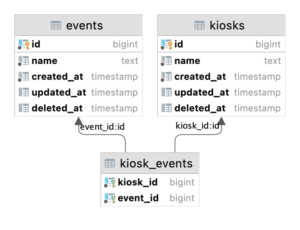Twelve Golden Rules From The Kitchen For Effective Leadership: ‘Mise En Place’
We’ve often been taught that “faster is better” when hustling to get a job done, but during my time working in the catering business, I learned...

A join table is the traditional tool used to define a "many-to-many" relationship in a SQL database. Here is a real-world example of how Merit's team created a join table with Liquibase and Gorm.
Merit is a digital credentialing company offering a check-in app. It enables organizations using the platform to issue digital credentials to individuals who register for events and restrict entrance to those with proper credentials. Our Merit Check-in app has a "many-to-many" relationship between kiosks, where people enter events, and events, which can be on multiple kiosks.
Events and kiosks have a simple model, just a name, id, and three timestamps. See gorm.Model for more information about the timestamps. The join table is a set of id pairs that link arbitrary kiosks and events.
This Liquibase file can be used to create the kiosks and events tables and is about as simple as Liquibase gets. It generates two tables, each with its own primary key.
Once the kiosks and events tables are created, the join table can be set up. With only two fields, it’s a small Liquibase file, but has two important characteristics. First, it’s two columns are used as a composite primary key which ensures there is only one link between a given kiosk and event. Second, both event_id and kiosk_id are foreign keys on the events and kiosks table, respectively. This ensures the join table will always reference valid kiosks and events.
A kiosk is now a valid place for event check in because of the link between the event and the kiosk. By adding a new entry to the join table, a kiosk and an event are linked. The two objects are joined together as part of their "many-to-many" relationship.
You can view a kiosk and its associated events. Gorm offers several methods to create what is essentially a SQL join. Preload was used to populate this many-to-many relationship. It issues multiple SQL queries, one for each table needed.
Use this function for endless real-word applications Here are more examples in a working repo here. Golang, Liquibase, and Docker need to be installed to construct similar tables. You can see instructions in the README.md file. This is just one more case study of how Merit engineers build software. If you're interested in joining our team, please visit our Careers page!
We’ve often been taught that “faster is better” when hustling to get a job done, but during my time working in the catering business, I learned...
Your people are your most valuable asset and your biggest competitive advantage. Invest in them wisely, and they’ll take your company places you...
Big workforce initiatives thrive on strong collaboration between ecosystem partners; however, navigating those projects may sometimes be challenging....